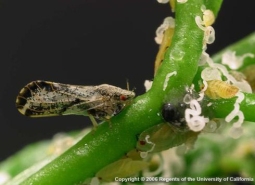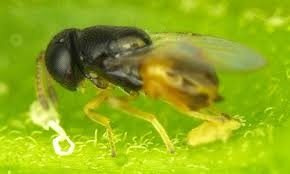- Author: Ben Faber
To help Ventura County's citrus community better understand the nature of the ACP epidemic — and the bitter lessons from Florida's failure to address it proactively — Farm Bureau and the ACP-HLB Task Force will host a workshop on Dec. 2. As speakers, we've invited three experts whose presentations were among the most compelling at last February's International Research Conference on HLB in Florida:
- Mike Irey, director of research and business development for Southern Gardens Citrus (which farms nearly 15,000 acres of oranges in Florida), who will speak about conditions in his state and provide an industry perspective on what it's like to live with HLB for a decade;
- Dr. David Bartels, an entomologist at the U.S. Department of Agriculture's Mission Laboratory in Texas, who will discuss his analysis of HLB survey data and what it can tell us about possible HLB infection sites throughout Southern California;
- Dr. Neil McRoberts, an epidemiologist and associate professor of plant pathology atUC Davis, whose computer modeling and research into the economic and social factors affecting disease spread can help guide development of an HLB management strategy for California.
The workshop will be from 1 to 4 p.m. on Wednesday, Dec. 2, at the Museum of Ventura County, 100 E. Main St., Ventura. It's free, but RSVPs are required. Please contact us at info@farmbureauvc.com or (805) 289-0155 if you plan to attend.

- Author: Ben Faber
There is some variability in citrus susceptibility to both the psyllid (Westbrook et al and Hall et al) and the bacterial infection (Shokrollah et al and Stover and Mc Collum). It is not fully clear at this point which of these species would be best to include in a breeding program, but both scions (http://www.concitver.com/3erEIIC2011/Viernes_23_sep/Ed_Stover/Ed_Stover.pdf) and rootstocks (http://www.flcitrusmutual.com/files/4cbb1e3c-1e1f-4b04-a.pdf) are being evaluated.
Some varieties like Australian Finger Lime (Microcitrus australasica) might show more resistance/tolerance to HLB than other species. At the UC Citrus Variety Collection website, it's possible to see the wide range of citrus species that are available for breeding and the commercial availability of those species. The collection is a view into the different materials that breeders can select from, in order to improve resistance to this citrus disease.
Citrus Variety Collection
http://www.citrusvariety.ucr.edu/
Australian Finger Lime Collection and Availability
http://www.citrusvariety.ucr.edu/citrus/microcitrus.html
Susceptibility to Infestation by Asian Citrus Psyllid
Catherine J. Westbrook1, David G. Hall2, Ed Stover, and Yong Ping Duan
http://www.ars.usda.gov/SP2UserFiles/Place/66180000/Westbrook%20et%20al%202011%20HortScience.pdf
D. Hall, C. Westbrook, Y.-P. Duan, E. Stover, R. Lee and M. Richardson http://citrusagents.ifas.ufl.edu/events/fl_citrus2011/Hall%20ACP%20IR%20Citrus%20Expo%202011.pdf
Susceptibility to HLB
Hajivand Shokrollah, Thohirah Lee Abdullah, Kamaruzaman Sijam,Siti Nor Akmar Abdullah and
Nur Ashikin Psyquay Abdullah
http://thescipub.com/PDF/ajabssp.2009.32.38.pdf
Ed Stoverand Greg McCollum
http://hortsci.ashspublications.org/content/46/10/1344.full.pdf+html
Photos
Australian Finger Lime Fruit
Australian Finger Lime Tree


- Author: Ben Faber
Per CDFA:
One adult (female) Asian Citrus Psyllid was identified from a trap in Hollister CA. Delimitation trapping will commence, along with visual survey, treatment and quarantine activities, following the newly approved Northern California protocol.

- Author: Ben Faber
SACRAMENTO — An additional portion of Fresno County along its southern border with Tulare County has been placed under quarantine for the Asian citrus psyllid (ACP) following the detections of ACP in two locations in an unincorporated area of northern Tulare County near the City of Orange Cove. The quarantine expansion adds approximately 50 square miles to the existing quarantine for a total of 84 square miles in Fresno County. All of Tulare County remains under quarantine as a result of previous ACP detections.
The new quarantine area in Fresno County is bordered on the north by E Kings Canyon Road; on the south by the Fresno County Boundary Line; on the west by S Alta Avenue; and on the east by an unnamed creek. The quarantine map is available online at www.cdfa.ca.gov/plant/go/acp-qmaps.
The quarantine prohibits the movement of citrus and curry tree nursery stock out of the quarantine area and requires that all citrus fruit be free from ACP prior to moving out of the quarantine area. An exception may be made for nursery stock and budwood grown in USDA-approved structures which are designed to keep ACP and other insects out. Residents with backyard citrus trees in the quarantine area are asked not to transport citrus fruit or leaves, potted citrus trees, or curry leaves from the quarantine area.
ACP county-wide quarantines are now in place in Imperial, Los Angeles, Orange, Riverside, San Bernardino, San Diego, Santa Barbara, Tulare and Ventura counties, with portions of Fresno, Kern, Madera, San Joaquin, San Luis Obispo, and Santa Clara counties also under quarantine.
The ACP is an invasive species of grave concern because it can carry the disease huanglongbing (HLB), also known as citrus greening. All citrus and closely related species, such as curry trees, are susceptible hosts for both the insect and disease. There is no cure once a tree becomes infected; the diseased tree will decline in health and produce bitter, misshaped fruit until it dies. HLB has been detected just once in California – in 2012 on a single residential property in Hacienda Heights, Los Angeles County. This plant disease does not affect human health.
Residents in the area who think they may have seen ACP or symptoms of HLB on their citrus trees are urged to call CDFA's Invasive Species Hotline at 1-800-491-18991-800-491-1899 FREE. For more information on the ACP and HLB, please visit: www.cdfa.ca.gov/go/acp.
—California Department of Food and Agriculture

- Author: Ben Faber
Mark Hoddle of UC Riverside Entomology Department has intorduced a second species of natural enemy of Asian Citrus Psyllid (ACP), Diaphoencyrtus aligarhensis, imported from Punjab, Pakistan. It was officially released December 16, 2014 at the Biological Control Grove at UCR. It is anticipated that this natural enemy will be complimentary to Tamarixia radiata, a parasatoid that also attacks ACP nymphs that was released in California in 2011. It's thought that it might occupy slightly different environments where it might be more successful than Tamarixia.




